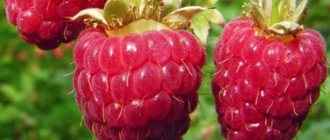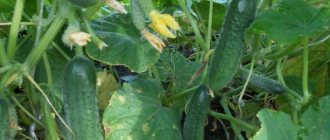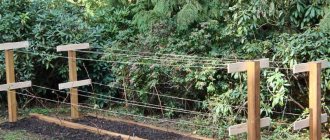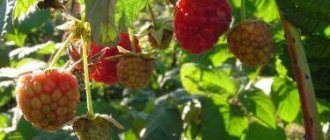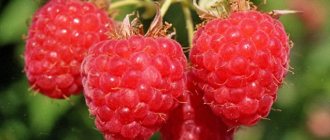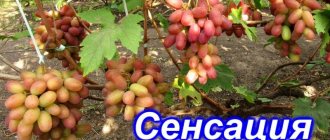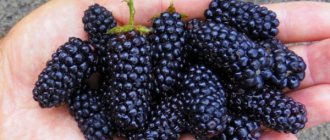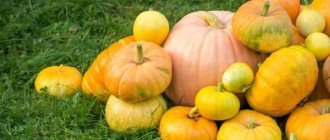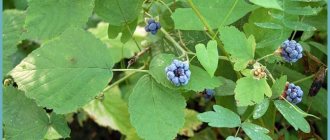Raspberry Indian Summer: reviews, photos, description, planting and caring for the variety
Raspberries are one of the most popular berry bushes among gardeners in our country. And in almost every garden plot you can find different varieties of this berry crop. However, recently, remontant raspberry varieties have become very popular. And one of the best remontant varieties is the Indian Summer raspberry.
The content of the article:
1. History of breeding of the variety 2. Description and main characteristics 3. Raspberry yield 4. Diseases and pests 5. Positive and negative qualities 6. Nuances of planting and caring for raspberries 6.1 Planting 7. Reviews of those who planted
History of variety development
This remontant species was bred by the Russian breeder I.V. Kazakov, who took raspberry varieties as a basis:
- Kostinbrodskaya;
- Kuzmin's news.
Raspberry Indian Summer was zoned specifically for the central and northwestern regions of our country. You can also grow it in the North Caucasus.
Good varieties of raspberries!
• Eurasia • Eurasia
Description and main characteristics of the variety
Indian Summer berry bushes are low and slightly spreading. The shoots are straight, with slightly sloping tops, up to 1.3-1.4 m high. The thickness of the stems is medium, they are completely covered with thorns, hard to the touch. The color of young shoots is light pink, older shoots are light brown with a slight coating of wax. The number of shoots formed per season is average, about 12-14 pieces. Side stems are well formed on the shoots, and inflorescences also grow in clusters.
The foliage is medium in size, slightly wrinkled, the surface is smooth. The color is deep emerald. The leaves practically do not curl.
The weight of the berries is average, up to 3 g, their shape is cone-shaped, slightly truncated. The color of ripe fruits is bright red, they are practically devoid of the aroma typical of raspberries. The taste is good, sweetish-sour. Since the variety is classified as remontant, the harvest can also be harvested from annual shoots - from the end of August until the cold weather.
Collection and storage
The variety bears fruit 1 or 2 times a season. The berries are harvested after full ripening. Productivity is within 1-3 kg per bush. They are not stored for a long time, so you should try to quickly process, eat or sell them. The fruits make excellent homemade preparations.
Indian Summer is a remontant variety recommended for planting in regions with a temperate climate. Resistant to diseases, produces 2 harvests per season. You can harvest the fruits in mid-autumn; during the autumn rains they do not lose their quality and shape. Suitable for eating fresh and also for canning.
Raspberry productivity Indian Summer and Indian Summer 2
The yield of the Indian Summer variety is slightly below average - up to 1.2 kg of berries per bush. However, with timely fertilizing and good care, experienced gardeners harvest 2.5-2.9 kg of ripe fruits from each bush.
There is another variety of this variety - number 2, this type of Indian Summer has larger berries and can weigh up to 3.5-3.9 g. The harvests of the second variety are more abundant. Indian Summer 2 bushes have better resistance to varieties of fungal diseases and are practically not affected by spider mites.
In autumn, harvesting begins from the first ten days of September until the onset of cold weather. During the autumn months, up to 1 kg of ripe berries are collected from each bush. Experts recommend growing this remontant variety as an annual rather than biennial, then the yield of Indian Summer raspberries will be higher.
Another positive quality of the variety is that the berries do not lose their presentation and taste even in rainy seasons.
The berries of both the regular variety and Indian Summer 2 raspberries do not tolerate transportation very well. The fruits are universal - suitable for fresh consumption, and the berries also make delicious jam and compotes.
Landing Features
To successfully grow Indian Summer raspberries, a number of factors must be taken into account.
Selecting a location
The brightest corners of the garden should be allocated for plantings. It is advisable that the area be in the sun all day.
In areas with a cold climate, it is preferable to plant the crop on the south side of the sheds, protecting the plantings from gusts of wind with a fence, hedge, or trees. In such places, a warmer microclimate is created, active snow melting is observed in spring, and the soil warms up faster. However, you should not plant raspberries too close to fences or other plantings - even slight shading delays ripening and worsens the taste of the berries. Only in the southern regions, in order to save the crop from the hot rays of the sun, places with slight shading are acceptable.
Raspberries feel comfortable in bright corners of the garden, enclosed by a fence.
The crop is undemanding to soil conditions, but prefers to grow on loam or sandy loam soil with neutral acidity. It is not advisable to plant raspberries in clay areas - fruiting will be significantly weakened. The composition of clay soil can be improved by adding sand (1 bucket/1m2). Sandy areas may be suitable with ample fertilization and watering. Acidic soil is alkalized by adding 500 g of lime/m2.
Previous crops are very important for raspberries. You should not plant a berry garden in areas where tomatoes and potatoes previously grew. The crop grows well after cucumbers, legumes, and zucchini. Raspberries get along well next to apple trees, cherries, and red currants. It is advisable to plant grapes and sea buckthorn in another corner of the garden. The berry garden can be returned to its original location after 5 years.
You should not allocate low-lying areas for raspberry gardens, where cold air lingers and water stagnates after rain. The occurrence of groundwater must be at least 1.5 m from the surface. Raspberries are also not suitable for very elevated areas, where snow is blown away in winter, and in summer the plants suffer from lack of moisture.
Landing dates
Bare-rooted seedlings can be planted early in the season, before buds open. However, during spring planting, fruiting is less abundant, because the plant directs all its energy to rooting. The most suitable period is autumn, 20–30 days before the soil freezes permanently. Plants planted in the fall will have time to take root, adapt to new conditions and become hardened for the winter.
Recently, there has been an increasing practice of planting container seedlings throughout the season. After only 3 months they produce 1–1.5 kg of berries per square meter of plantings.
Selection of seedlings
Fruit-bearing raspberries can only be grown from high-quality planting material. Nurseries offer varietal seedlings adapted to a given area. Each plant has an accompanying certificate containing information about the variety, age, and care features.
The seedling must be carefully examined: its root system should be developed, fibrous, without mold, and its branches should be 8–10 mm thick, flexible, and without spots. It is advisable to buy container plants - 2-year-old raspberries with a well-formed powerful root system, ready for replanting.
When selecting seedlings, first of all, pay attention to the root system - it must be well formed
If seedlings are purchased just before the cold weather, when it is too late to plant them, they are buried in the garden. Make a ditch 15 cm deep with one sloping side, place plants on it, cover it with earth, compact it so that the cold wind does not penetrate to the roots. Spruce branches are thrown on top - in such a shelter the raspberries will not freeze in winter and will be reliably protected from rodents.
Landing rules
Preparations for planting work are carried out in advance. 20 days before planting, fertilizers are applied per square meter to the dug up and cleared of weeds area:
- 20 kg of humus,
- 50 g superphosphate,
- 30 g of potassium salt (or 300 g of ash).
You can use the complex composition of Kemira universal (70 g/m2), Stimul (30 g/m2). Acidic soil is alkalized with lime (500 g/m2).
Raspberries are planted using a bush or linear method. When forming a raspberry tree, 60x45 cm holes are prepared from individual bushes, leaving 1 m between them. 2 bushes are planted in one hole. When planting linearly, seedlings are placed in 50x45 trenches with an interval between plants of 70 cm, between rows of 1.5–2 m.
On large plantations, raspberries are usually planted in a linear manner.
The process of planting raspberries consists of the following steps:
- 2 hours before planting, the plants are immersed in a solution of Kornevin and Heteroauxin - biostimulants that accelerate root formation and increase stress resistance. Flint fungicide can be added as a preventative against root rot.
- A mound of fertile soil is placed at the bottom of the hole or furrow.
- A seedling is lowered onto it and the root system is evenly distributed over it.
A seedling with straightened roots is lowered into the planting hole
- Cover the plant with soil, holding it so as not to bury it. The root collar should be at ground level.
- 5 liters of water are poured into the hole formed around the bush.
After planting, the seedling is well moistened by pouring 5 liters of water into the hole.
- Mulch the root zone with straw.
- Shorten shoots to 40 cm.
In early spring, experienced gardeners cover the raspberry tree with a black film that attracts the sun's rays. The snow under the film will melt faster, the ground will warm up better, therefore, shoots will begin to grow earlier and the yield will be higher.
Video: methods of planting remontant raspberries
Diseases and pests
The Indian Summer raspberry variety is highly resistant to curl and gray rot. However, the resistance of this shrub to powdery mildew and purple spot is below average, so preventive treatment of this berry with appropriate fungicides should be carried out to prevent the development of diseases.
Among insect pests, this berry crop can be affected by spider mites. You can fight this pest using folk remedies, in particular, treating the vegetative mass with an infusion of garlic or onion. Also an effective folk remedy in the fight against spider mites is a soap solution that is sprayed on the foliage. If there are too many of these pests on the shoots, then you have to resort to treating the bush with insecticides.
Photo of Indian Summer raspberries
Positive and negative qualities of the variety
The positive qualities of the Indian Summer variety include:
- the variety is remontant, so the harvest is harvested on one-year and two-year-old shoots;
- taste qualities do not deteriorate during rainy and cool seasons, the amount of sugars in fruits does not decrease;
- varieties are highly resistant to curl and gray rot;
- Indian Summer raspberries are highly frost-resistant; at temperatures down to -28 degrees, covering the bushes with snow cover is sufficient.
The disadvantages include:
- the crop does not tolerate transportation very well;
- bushes may be affected by powdery mildew, purple spot;
- the Indian Summer variety is often affected by spider mites;
- New growth is not appearing very actively.
Reproduction
new shoots will grow from the root . This can only be done on a plant that is 3 years old. The grown sprouts are left for a while, then transplanted to a new place.
Can be propagated by planting cuttings . To do this, carefully separate the shoot, which is 20 cm high with roots; their color should be white, this is what the new roots look like. This is done in late spring and early June. If the shoots are taller than 20 cm, they can be trimmed.
Nuances of planting and caring for Indian Summer raspberries
Indian Summer raspberry seedlings are planted in the same way as other varieties of this berry bush. It should be remembered that among predecessors it is better to avoid nightshade plants, as well as places where other types of raspberries used to grow.
Raspberry Indian Summer - video
Landing
The best time for planting Indian summer raspberry seedlings is early and mid-autumn. Although, if necessary, planting can be done from mid-spring and even in summer.
Useful article:
Pruning raspberries in spring, summer and autumn
The site is prepared in advance - when planting in the fall, soil preparation begins in the spring, when planting in the spring - from the fall of the previous season. Humus, compost or rotted manure should be added to the soil to saturate the soil with useful substances.
Planting is done in rows in trenches or planting holes. When planting, a layer of drainage material is placed on the bottom, then a prepared nutrient substrate composed of garden soil, turf, peat and river sand, taken in equal quantities. Complex mineral fertilizers should also be applied to each square.
After planting seedlings, basic plant care consists of:
- timely watering;
- loosening row spacing after watering while simultaneously removing weeds;
- applying fertilizers. Typically, during the season, fertilizers for Indian Summer raspberries are applied: a couple of weeks after planting, during flowering, during the ripening period of fruits, in the fall after harvesting the last harvest;
- pruning bushes before the onset of frost. You can also prune in the spring, removing frozen, damaged and weak shoots.
How to reproduce?
The variety is propagated in late May - early June by transplanting root suckers:
- At a distance of 30-40 cm from the base of the mother bush, a young shoot 20-30 cm high is selected.
- Remove the top layer of soil to expose the upper part of the root branch, and use a shovel to cut off the shoot from the bush.
- The dug up seedling is placed in a separate hole at the same level at which it grew previously.
Important! A young plant can freeze in winter, so after a persistent cold snap sets in, it is covered with agrofibre or spruce branches.
Raspberry Indian Summer: reviews from those who planted
Below are reviews from gardeners who have grown Indian Summer raspberries for more than one season.
Inna, 44 years old, Voronezh:
Raspberries are one of my family's favorite berries. Therefore, different varieties were planted, with emphasis placed on the following qualities of this berry plant: fairly good yield, good taste of ripe berries, resistance to cold and most diseases. Of all the varieties, I liked the remontant raspberry Indian Summer the most. But we prefer to grow this berry as an annual one - it has already been noted that such shoots can yield a larger harvest than when grown biennially.
Tatyana, 38 years old, Ryazan:
Of the remontant raspberry varieties, I was advised to plant Indian Summer raspberries on the plot. I liked that we harvest twice a season - at the end of July and in September. But I would like to note that it is better to process the harvested crop immediately after harvesting, since the berries do not tolerate transportation well.
Maria, 33 years old, Tambov:
Indian Summer raspberries have been growing on my site for more than one season. Previously, I grew only ordinary varieties of raspberries, but then I decided to try to grow a remontant variety and I was right. Indian Summer raspberry bushes bear fruit almost all summer, taking a short break in the middle of the season. If you regularly fertilize, the yield of the variety increases.
Ekaterina, 46 years old, Ulyanovsk:
I planted the remontant raspberry variety Indian Leto three seasons ago and decided to see which type was better: the regular one, which was already growing on my site, or the remontant one. Over these seasons, I came to the conclusion that with the same care, it is much more profitable to grow remontant raspberries, so now I plant only the Indian Summer variety on the plot. The harvest from this raspberry tree is enough to eat fresh and make jam. We freeze some of the ripe berries and even have some left over for sale.
When and how to plant?
Seedlings are planted when they are 15-20 cm in height. This is done at the end of May or beginning of June, when there is no rain. It can also be planted in the fall, when buds are visible on the neck.
The seedlings are placed in holes and the roots are straightened. Then the soil is poured so that the buds of the stem are 2-3 cm deep in the soil. Then the soil must be loosened and watered abundantly; 6 liters of water are poured under each bush.
Mullein is well suited as a top dressing. To prepare the site, you need to pull out the weeds, dig up the soil 30 cm. Pour 2 buckets of humus or compost, 1 cup of superphosphate and 1 cup of potassium sulfate per 1 m² of soil. Dig planting holes 40-60 cm in diameter and 30-40 cm deep.
Malin a loves moisture, but does not tolerate waterlogging, because of this its rhizomes begin to rot and raspberry dies.
Water the bushes every day, then pull out the weeds. Loosen the soil once every 1.5-2 weeks by 6-7 cm. Then mulch with humus or peat soil. Then you will have to water less often, and humus will ensure the supply of nutrients to the plant.
The first time is fed in the spring, as soon as the snow melts. In spring and summer they are fed with nitrogen, and by autumn - with mineral fertilizers.
It is best to fertilize raspberries in April, May and June . To do this, dilute 1 part of bird droppings in 20 parts of water or 1 part of manure in a bucket of water (10 l).
At the end of summer, make a solution of 15 g of nitrate, 40 g of superphosphate and 20 g of potassium sulfate per 10 liters of water. One bucket is enough for 2-3 bushes.
In the fall, add 30 g of potassium sulfate and 30 g of superphosphate per 1 m².
